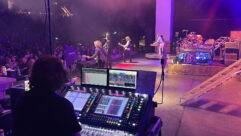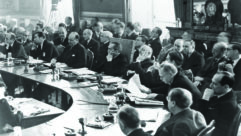Fixing It
Apr 1, 2001 12:00 PM,
Ted Uzzle
THIS REVIEW, AND MY EXPLORATION OF THESE THREE BOOKS, BEGAN with a simple question: Are there general principles of diagnosing and repairing faults in electronic products and electronic systems? Obviously there are particular repair instructions for each individual electronic product you might encounter, even if the odds of those instructions being intact and available when needed are close to nil. But are there deeper principles that can be applied across multiple products, even across multiple categories of products? Are there deeper principles that can be applied to systems of electronic products?
In a word, yes. There are. Many of us learned electronic servicing by induction, by repairing this and repairing that, and by repetition, eventually discovering similarities of technique. Things are much easier for the repairer who brings to bear general ideas early in the career.
The largest of the guide books that outline the deeper principles is The Complete Guide to Electronics Troubleshooting by James Perozzo. It opens with a chapter on necessary basics, introducing the engineering number system, component identification, schematic symbols and the like. This is followed by a chapter on the categories of electronics failures. Here we see hum, motorboating, intermittents, distortion and our old friend operator-induced faults. The third chapter deals with problems in electronic systems and introduces the requirements of multiple components connected one after another. Here, isolating the problem to one component, or to one interconnection, is merely the first step; then, the troubleshooter must find the fault in the component or interconnection.
The next two chapters are applicable to all sorts of electronic devices. The fourth chapter describes how to get into the equipment, how to deal with interlocks, how to locate the internal bits you want to study and how to keep from being electrocuted. The next chapter shows how to use a voltmeter in electronic repair, including what the author calls the Perozzo method for troubleshooting. If you measure a voltage (or a signal level) that is too low, there are five categories of reasons why it might be too low, five places to look, five things to check out. If you measure a voltage (or a signal level) that is too high, there are five categories of reasons why it might be too high, five places to look, five things to check out. These are based on the simplest ideas of series and parallel resistors but apply to all passive and active devices. They are the “Holy Grail” of general principles for finding and fixing faults, simple and valuable enough to memorize in a few minutes but powerful enough to apply anywhere in electronic troubleshooting.
The middle three-quarters of the book are devoted to specific components, such as audio equipment, RF equipment, pulse equipment, as well as the devices within them: power supplies, discrete transistors, ICs, vacuum tubes, CRTs and the like.
The last section wraps up the subject with chapters on parts replacement, final inspection, installation and preventive maintenance. The final chapter, “What an Electronic Technician Does,” turns to the nature of work in the factory environment (assembling, testing and re-working), in field service (at the contractor’s bench and on the installation site), and in the design laboratory (building prototypes, etc.).
Electronic Troubleshooting by Dan Tomal and Neal Widmer is only half as long (and costs only half as much) as the book by Perozzo. It doesn’t give as many examples, and it doesn’t look into as many specialty areas. It does, however, attempt to discover and describe the general concepts that underlie all electronic diagnostics and repair. It thus presents a fascinating counterpoint to the larger book.
Tomal and Widmer begin by identifying the seven basic categories of circuit faults: heat, moisture, dirt and contaminants, abnormal or excessive movement, poor installation, manufacturing defect, and animals and rodents. In the same way, there are 17 fundamental troubleshooting techniques, such as testing with a megohmmeter, substituting, tapping, heating or freezing.
A chapter on electronic test instruments introduces a variety of them, and how they are used in troubleshooting. There follow chapters on the specifics of motors and generators, industrial controls, residential and industrial wiring, digital circuits, sequential digital circuits, microprocessor-based equipment, and biomedical equipment. These chapters are quite specific, and the reader considering buying the book may want to consider how useful they might be. Of certain usefulness, however, are the 11 appendices, with quick-reference troubleshooting tables organized by component category. There’s nothing quite like this in the larger book by Perozzo. In each table, there’s a column of symptoms set next to things to check first. Both books offer explanations and training, but only the latter offers first aid when needed in a hurry: Got this problem? Try that.
Homer Davidson’s Troubleshooting Consumer Electronics Audio Circuits is a horse of an altogether different color. While it deals with the basics of audio circuit tests and operating audio test equipment, it includes almost no general principles of troubleshooting. It has no quick guides for isolating problems. It is illustrated throughout by examples from real audio-product service troubleshooting, but the equipment used in the examples is laughably antique. The diagrams use miniscule symbols and microscopic type, while the photo illustrations are murky and illegible. If you’re evaluating this book in the bookstore, look at figure 7-15 on page 144, or figure 8-9 on page 157. I found these by flipping through and letting the book fall open at random. This book is the same price as Tomal and Widmer’s Electronic Troubleshooting, but isn’t worth a tenth.
No book reviewer in recent years can escape wondering what has happened to Howard W. Sams and its various imprints. Why have its products become so consistently inferior? Loss of interest? Corporate gyrations? Who knows? Who cares? Some high muckety-muck threw a switch, and Sams titles became poor value for the money. When they print inferior books, they seem to have no intention to pass the savings along to you. We are fortunate, indeed, that McGraw-Hill and Delmar and Butterworth and others have stepped into the breach.
I give the highest recommendation to Tomal and Widmer’s Electronic Troubleshooting as the best value for the money. A much bigger book, for much more money, is Perozza’s Complete Guide to Electronics Troubleshooting. It’s an excellent value for the money. There are genuinely important general principles for electronic diagnostics and repair, and these books teach them well.
Ted Uzzle is editor emeritus of S&VC.
James Perozzo, The Complete Guide to Electronics Troubleshooting, Delmar Publishers, cloth, 1994, xiv + 850 pp., $89.95.
Dan R. Tomal and Neil S. Widmer, Electronic Troubleshooting, second edition, McGraw-Hill, paper, 1999, xviii + 377 pp., $34.95.
Homer Davidson, Troubleshooting Consumer Electronics Audio Circuits, Prompt Publications (div. Howard W. Sams), paper, 1999, 277 pp., $34.95.










